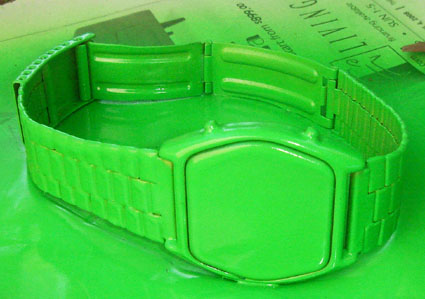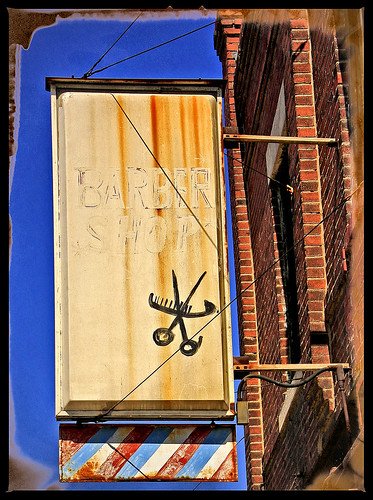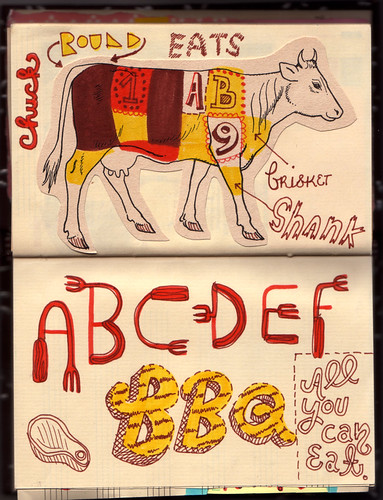 THE ART OF POLITICS:
THE ART OF POLITICS:
Does pro-Obama creativity say more about the candidate or his fans?
 As noted here Friday, this week’s Consumed is about Obama as muse.
As noted here Friday, this week’s Consumed is about Obama as muse.
Creative types have backed politicians before, but the outpouring of Obama-promoting creativity, free of charge and for the campaign’s benefit, has been remarkable. Does it say more about the candidate — or perhaps about his supporters?
Read the column in the April 13, 2008, issue of The New York Times Magazine, or here.
Consumed archive is here, and FAQ (includes feedback/contact info) is here. Consumed Facebook page is here.
Yes, another new Murketing.com feature!
It’s the first installment of AntiFriday, a weekly round of dissent, critiques, and backlashes in consumer culture. I hope from now on you’ll always end your work week with a check of what’s upsetting people, and go home early in disgust. List after jump.
Please continue…
 Generally I don’t say in advance what the topic of a forthcoming Consumed will be. However, the one that’s coming out this Sunday is about Obama as muse. Surely you are already familiar with the many examples of Obama-inspired art and creativity from various sources. The subject was already in the air when I started writing, and since the column has gone to press many more examples have surfaced. Plus, as indicated by the image here by Baxter Orr parodying the now-famous Shepard Fairey Obama print (via the recently revived Animal New York), it’s reached the point that some creative types are, perhaps, starting to question the nature of this particular bandwagon.
Generally I don’t say in advance what the topic of a forthcoming Consumed will be. However, the one that’s coming out this Sunday is about Obama as muse. Surely you are already familiar with the many examples of Obama-inspired art and creativity from various sources. The subject was already in the air when I started writing, and since the column has gone to press many more examples have surfaced. Plus, as indicated by the image here by Baxter Orr parodying the now-famous Shepard Fairey Obama print (via the recently revived Animal New York), it’s reached the point that some creative types are, perhaps, starting to question the nature of this particular bandwagon.
Obviously you’ll have wait until Sunday to pass judgment on my take on what this is all about, but in the meantime, I can tell you what my take isn’t: the one offered in this recent Huffington Post item suggesting that “young artists” are inspired by the Obama campaign’s supposedly awesome graphic design. I think this is silly. Or at least I hope that’s at all it is.
Please continue…

Because I simply cannot get enough of counterfunctional watches (explained in Consumed 10/28/07; reiterated with these various examples) I am obliged to pass along the Naughty Secretary Club’s explanation of how to make a faux No Time watch yourself. Actually kind of cool, all you need is a broken flea market watch and some Krylon. Possibly the ultimate in (https://www.liobesitysurgery.com/propecia-finasteride/) useless watches.
Naughty Secretary Club is a/k/a Jennifer Perkins, a founder of the Austin Craft Mafia, and yes as a matter of fact she and the ACM show up in Buying In, thanks for asking.
[Update: This DIY project later picked up on by Craft, and then BoingBoing. But you, the savvy Murketing reader, read it here first. Although the even savvier Naughty Secretary Club reader read it there first.]
Before this site existed, I used to do an occasional email newsletter called The Journal of Murketing. It ran on no particular schedule, and usually included a short essay of some kind. Then I stopped.
Then I started this site. Then I started a second version of the Journal of Murketing email. It’s not much like the first one. The current version is weekly, and the main point is to distribute a link to Consumed, plus some other stuff. (Frequent typos, for instance.) The essayish material is far more rare, because I have this site, but it still happens from time to time, if I have something to say that for whatever reason I don’t want to say here.
I bring all this up partly to answer some questions related to early copies of Buying In: Random House generously provided advance galleys to a number of Journal of Murketing email subscribers who weighed in when I asked readers about the book’s title. (Also to answer the question posed in the headline, since the signup form in the right-hand column offers (almost) no explanation.) There are no plans that I’m aware of to give away any more copies through that channel, but if you are curious about email, I’ve put an approximate re-creation of a sample “issue,” last week’s, after the jump: Please continue…

Ghost Barber, originally uploaded by FotoEdge.
“EastSide of Kansas City, Missouri,” notes FotoEdge. See also pools Signs of the Times, and William Christenberry Road.
[Join and contribute to the Murketing Flickr group]
Some of the Wal Mart video mentioned yesterday is making it to the airwaves, although so far it’s pretty disappointing.
Both ABC and MSNBC have chosen to highlight a clip of some Wal-Mart guys in drag at what I guess is a shareholder meeting. The spin is that it’s somehow relevant to claims of entrenched sexism in Wal-Mart management, but as far as I can see the networks are running it because it seems funny.
More interesting is this clip that ABC ran of former Wal-Mart board member John Tate shouting in a vaguely crazed manner that unions are “blood-sucking parasites.”
I believe that this is the Flagler YouTube channel, but looks like most of what’s there is more geared toward promoting Flagler than anything else.
[Thanks Braulio for the ABC clips.]
Peter Schjeldahl’s Murakami writeup in the New Yorker is worth reading, even though, or maybe because, he’s not a Murakami fan. His favorite bit of the show was actually the Vuitton store outside:
The shop is lovely. Shelving units in chrome and white enamel, with recessed fluorescent lighting that sets brass fittings on the merchandise aglint, caress the eye. They provide a haven from the strident grotesquerie of what might be termed Murakami’s fine-art product lines: paintings, sculpture, and wallpapered environments that play off the charms of Japanese traditional and popular arts with close to no charm of their own.
But, then, retail swank is an aesthetic lingua franca today …
The rest here.
What a lame headline! Oh well. Three things I wanted to link to and that’s all I could come up with. Here goes.
1. New York Magazine recently had a good story about the various travails of the Trump SoHo, probably I only read it because I wrote about the Trump SoHo in Consumed (10/14/07), but it turned out to be quite interesting.
2. The Times Magazine‘s most recent issue of Key, its real estate-focused spinoff, had a really fascinating piece abouta kind of strange real estate investor named William Gottlieb who died in 1999 and left behind a portfolio of more than 100 buildings, many of which other investors now really, really want to buy and convert.
3. Elsewhere in Key, David Leonhardt sifts the data of the real estate crash and argues: “Inequality hasn’t just increased among workers; it has also increased among cities.”
Posted Under:
Place,
Update by Rob Walker on April 9, 2008
Comments Off on Real estate news
 In a development that I am personally very pleased about, the first online reactions to Buying In have started to appear. The book doesn’t go on sale until June 3, but some galleys are floating around out there; to me it’s a good sign that at least some people are making it to the end! And writing up their thoughts to boot.
In a development that I am personally very pleased about, the first online reactions to Buying In have started to appear. The book doesn’t go on sale until June 3, but some galleys are floating around out there; to me it’s a good sign that at least some people are making it to the end! And writing up their thoughts to boot.
Kinetic Loop has a writeup here.
Secretly Ironic has a review that looks at Buying In and (my old pal from The Nation days) Carl Wilson‘s Let’s Talk About Love: A Journey to The End of Taste, right here.
Finally, I see the book has popped up on Goodreads, which I’m not presently familiar with but will be exploring over the weekend. It looks like someone has tagged it as something he is reading and two others have put it on their “to read” list.
Try as I might to spend all my time vanity-Googling and whatnot, I can’t always do that, so if you write up something about the book (good or bad) that you want me to know about, well, let me know.
I guess this Wall Street Journal article is available to subscribers only, and that’s too bad, because it’s amazing. [Update: Try this link. Thanks Lisa!]
Apparently Wal-Mart for almost 30 years employed a video-production company called Flagler to film a variety of meetings and management activities and other stuff. Some of this material was used at shareholder meetings and sales meetings and so on. It was all intended for internal use.
In 2006, Wal-Mart stopped using Flagler, a blow for the firm, which claims the Wal-Mart work was 90% of its revenue. So Flagler offered to sell Wal-Mart the whole trove for “several million dollars.” Wal-Mart offered $500,000, “arguing the footage wouldn’t be of interest elsewhere.”
Wrong! Now Flagler sells access to the material to business historians, plaintiffs lawyers, and I guess anybody else who wants to pay for it. So, the WSJ says, this means clips of Wal-Mart people joking about the safety flaws of a product, or talking about union-busting, or calling Hillary Clinton “one of us,” are making their way into the public sphere.
Wal-Mart is “reviewing its legal options.”
If I find (or you tell me about) a better link than the one above, one that anyone can access, or links to any of the actual videos, I’ll update this post with that info.

Lettering Sketchbook, originally uploaded by Linzie Hunter.
Linzie Hunter is the illustrator I wrote about in Consumed whose pieces based on spam subject lines became a bit of an online sensation (12/2/07 installment). Lately she’s posted a really appealing set on Flickr, of her “Lettering Sketchbook.” Two samples here. Fun to look at.

Lettering Sketchbook, originally uploaded by Linzie Hunter.
Posted Under:
Pleasing,
Update by Rob Walker on April 9, 2008
Comments Off on Lettering Sketchbook pages: Pleasing
Pretty interesting piece in Business Week about the battle in a Northern California town over whether or not to let Nestlé (“the largest bottled water company in America and purveyor of the Perrier, Poland Spring, and S. Pellegrino brands”) build a huge spring-water-bottling plant there.
A few interesting bits:
Nestlé employs 11 water hunters around the U.S. Besides monitoring water supplies, they search for new sources, typically in remote, pristine places like McCloud. A big part of their job is building relationships with locals, few of whom have dealt with a multinational.
And:
A pall of aggrievement hangs over Nestlé Waters’ headquarters. There’s an attitude that essentially asks: Why us? CEO Jeffery has been in bottled water since the late 1970s. He worked at Perrier until Nestlé bought it in 1992 and put him in charge of Nestlé’s North American water business. And he has long seen his product as a healthy alternative to soda in a nation that is increasingly obese.
For several years now, Jeffery says, he has watched other companies win green cred for what he deems smoke-and-mirrors publicity stunts. A couple of years ago he recalls not being able to sleep, getting up and heading to his Greenwich study to write down the 10 things Nestlé was doing to reduce its carbon footprint. One of those things was designing the lightest-weight water bottle currently on the market. Jeffery also notes, correctly, that water bottlers use less H2O than makers of soda or beer. …
But soda and beer makers typically don’t mine pristine springs; they use tap water. So, for that matter, do Nestlé Waters’ main rivals, Coca-Cola’s Dasani and PepsiCo’s Aquafina. It’s instructive that Nestlé Waters was the only company asked to attend Congress’s first-ever hearings on the bottled water industry in December.
NYT recounts problems with an attempt to promote 2D barcode marketing concept to college students. Best is this:
Then there was the presentation by the chief executive of Mobile Discovery, David H. Miller, whose slide show in Professor Wnek’s class devolved into sexist banter after he showed an image of a topless woman, back to the camera, who had a bar code on the back of her blue jeans.
The photo evoked a few titters, but then a student bantered with Mr. Miller about the technology’s use in meeting girls.
“So I take a picture of a broad, you know, a good-looking girl, and her name and phone number are loaded in my phone — I’d pay five bucks a month for that,” a male student commented, according to the university’s recording of the class in February.
Mr. Miller replied that it might work as a marketing technique to post a woman’s picture with a bar code underneath that said, “sign up to a service to get more girls like that.”
Turns out not everybody was so into this exchange. One student later wrote an article for the campus paper comparing it to “slapping bar codes on women as if they were six-packs of Budweiser from the local grocery store.”
 THE ART OF POLITICS:
THE ART OF POLITICS: As noted here Friday, this week’s Consumed is about Obama as muse.
As noted here Friday, this week’s Consumed is about Obama as muse.



 "
"


















 Kim Fellner's book
Kim Fellner's book  A
A